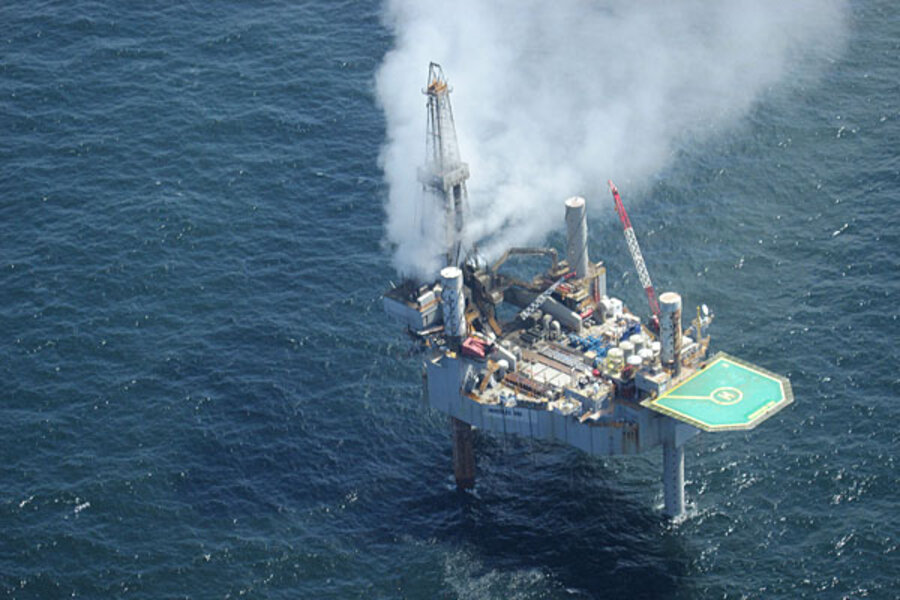Natural gas rig explodes, partially collapses in Gulf. How big a disaster?
Loading...
A natural gas rig that exploded Tuesday morning, burning and leaking natural gas off the Louisiana coast, partially collapsed Wednesday.
Forty-four workers were evacuated Tuesday and no injuries were reported, Eileen Angelico, a spokeswoman for the Bureau of Safety and Environmental Enforcement, said in a statement.
On Wednesday morning, BSEE inspectors reported a cloud of natural gas above the rig and a light sheen on the water, covering an area one-half mile by 50 feet. But they said the sheen had disappeared by Wednesday afternoon.
The cause of the blowout and the fire remain unknown, although questions are being raised about whether there was a problem with the rig's blowout preventers, the safety equipment that is meant to shut off out-of-control oil and gas wells.
A spokesman for the rig's owner, Walter Oil & Gas, "initially said the blowout preventer appeared to have failed, but the company later said it was still investigating the incident and wouldn't know the cause of the blowout, or why the well continued to flow, for some time," reported The Wall Street Journal.
Conflicting reports suggest it's unclear how long it will take to contain the blaze or stop the leak. Two firefighting vessels that were in the area pulled away from the rig after it collapsed and a third firefighting ship is en route, BSEE said.
Talos Energy, which CNN says is connected to the rig, said that it expects the leak to be plugged Wednesday. It said the well leaked about six barrels of a liquid form of raw natural gas, or about 252 gallons, and it expects the mixture to evaporate quickly.
Meanwhile, the Wall Street Journal report says Walter Oil & Gas "is preparing to move another drilling rig nearby in case a relief well is needed to stop the flow of gas." A relief well would intersect the ruptured well and provide another avenue for cement to plug it. This is how the Macondo well that caused the 2010 Gulf oil spill was plugged.
The key environmental concern in natural gas leaks of this type is the release of large amounts of methane. “Natural gas is mostly made up of methane, a greenhouse gas that has 25 times the warming power of carbon dioxide,” wrote Bryan Walsh in Time magazine last year. “[N]atural gas – in the wrong place – can do very real damage to the environment, even if it does so invisibly.”
Mr. Walsh references the natural gas leak in the Elgin gas field of the North Sea, where around 7 million cubic feet of natural gas were spilled per day from March 25 to May 16, 2012. If those rates had kept up for six months, as initially expected, the spill would have approximated "the annual global warming impact of putting 300,000 new cars on the road" because of the warming effects of methane, he wrote.
Another concern about natural gas leaks is the damage they can do to marine ecosystems. Jonathan Henderson of the Gulf Restoration Network, an environmental advocacy group in New Orleans, told CNN that toxicity in the water is a concern in this case.
"Toxic gases will damage the bodies of fish that come into contact by damaging their gills and causing internal damage," he said. "Marine species in the Gulf are more vulnerable when water temperatures are high and when oxygen concentrations are low like they are now."
The spill in Louisiana is creating another concern for regional fisherman. The well is close to Grand Isle, which is scheduled to start its annual Tarpon Rodeo, a fishing event expected to draw more than 15,000 sport and recreational fishers and tourists to the area, on Thursday.
The rig was completing a "sidetrack well" – a means of reentering the original well bore, according to the BSEE. Industry websites say sidetrack wells are sometimes drilled to remedy a problem with the existing well bore, although the purpose of this sidetrack well have not yet been confirmed.
"It's a way to overcome an engineering problem with the original well," said Ken Medlock, an energy expert at Rice University's Baker Institute in Houston. "They're not drilled all the time, but it's not new."
• Associated Press material was used in this report.








